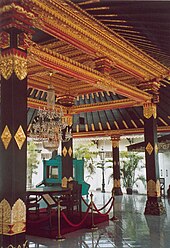Rhoma Irama Movies
-
Badai di Awal Bahagia
Begadang
Berkelana I
Berkelana II
Bunga Desa
Camellia
Cinta Kembar
Cinta Segitiga
Darah Muda
Gitar Tua
Jaka Swara
Kemilau Ci...
14 years ago
| [hide]Climate data for Yogyakarta | |||||||||||||
|---|---|---|---|---|---|---|---|---|---|---|---|---|---|
| Month | Jan | Feb | Mar | Apr | May | Jun | Jul | Aug | Sep | Oct | Nov | Dec | Year |
| Average high °C (°F) | 28.9 (84) | 28.9 (84) | 29.4 (85) | 30.6 (87) | 30 (86) | 30 (86) | 29.4 (85) | 30 (86) | 30.6 (87) | 31.1 (88) | 30 (86) | 29.4 (85) | 30 (86) |
| Average low °C (°F) | 22.2 (72) | 22.2 (72) | 22.2 (72) | 22.2 (72) | 22.2 (72) | 21.1 (70) | 20.6 (69) | 20.6 (69) | 21.7 (71) | 22.2 (72) | 22.2 (72) | 22.2 (72) | 21.7 (71) |
| Precipitation mm (inches) | 350 (13.78) | 330 (12.99) | 310 (12.2) | 210 (8.27) | 120 (4.72) | 80 (3.15) | 40 (1.57) | 20 (0.79) | 30 (1.18) | 90 (3.54) | 220 (8.66) | 340 (13.39) | 2,180 (85.83) |



| Malioboro, the most famous street in the city for shopping and eating out. | |||
| |||
| Nickname(s): Kota Pelajar (Student's City) or Kota Gudeg (Gudeg City) | |||
| Motto: Memayu Hayuning Bawono | |||
| | |||
Coordinates:  7°48′5″S 110°21′52″E / 7.80139°S 110.36444°E / -7.80139; 110.36444Coordinates: 7°48′5″S 110°21′52″E / 7.80139°S 110.36444°E / -7.80139; 110.36444Coordinates:  7°48′5″S 110°21′52″E / 7.80139°S 110.36444°E / -7.80139; 110.36444 7°48′5″S 110°21′52″E / 7.80139°S 110.36444°E / -7.80139; 110.36444 | |||
| Country | Indonesia | ||
| Province | Yogyakarta Special Region | ||
| Government | |||
| - Mayor | Herry Zudianto | ||
| Area | |||
| - City | 32.5 km2 (12.5 sq mi) | ||
| Population (2008) | |||
| - Density | 11,941/km2 (30,927/sq mi) | ||
| - Metro | 1,588,622 | ||
| Time zone | WIB (UTC+7) | ||
| Website | www.jogjakota.go.id | ||